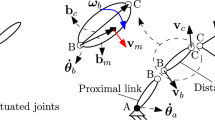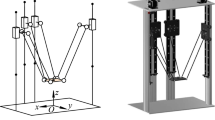Abstract
Redundant actuation is considered as a way to improve the properties of parallel manipulators as it increases and homogenizes the kinematic dexterity and the stiffness, and eventually eliminates singularities. It further allows for a purposeful distribution of control forces, taking into account secondary tasks, such as optimal force distribution, stiffness control, and backlash avoiding control. The actual model-based control builds upon an exact model of the manipulator. In this paper the effect of kinematic uncertainties on the applicability of established model-based control schemes is analyzed. It is shown that kinematic model uncertainties lead to parasitic perturbation forces that cannot be compensated by the controls. To tackle this problem amended versions of the augmented PD and computed torque control schemes are proposed.
Similar content being viewed by others
References
Abdellatif H, Grotjahn M, Heimann B (2007) Independent identification of friction characteristics for parallel manipulators. ASME J Dyn Syst Meas Control 129:294–302
Asada H, Slotine JJE (1986) Robot analysis ad control. Wiley, New York
Chakarov D (2004) Study of the antagonistic stiffness of parallel manipulators with actuation redundancy. Mech Mach Theory 39:583–601
Cheng H, Yiu Y-K, Li Z (2003) Dynamics and control of redundantly actuated parallel manipulators. IEEE/ASME Trans Mechatron 8(4):483–491
Dasgupta B, Mruthyunjaya TS (1998) Force redundancy in parallel maipulators: theoretical and practical issues. Mech Mach Theory 33(6):727–742
Garrido R, Torres-Cruz D (2004) On PD control of parallel robots with redundant actuation. In: IEEE international conference on electrical and electronics engineering (ICEEE), Acapulco, Mexico, 8–10 September 2004, pp 356–360
Gourdeau R, Blouin S, Hurteau R (1999) Computed torque control of robots without joint velocity measurements. In: IEEE Canadian conference on electrical and computer engineering, Edmonton, Canada, 1999, pp 1413–1418
Kim J et al. (2001) Design and analysis of a redundantly actuated parallel mechanism for rapid machining. IEEE Trans Robot Autom 17(4):423–434
Kock S, Schumacher W (1998) A parallel x-y manipulator with actuation redundancy for high-speed and active-stiffness applications. In: Proceedings of the IEEE international conference on robotics and automation, Leuven, 1998, pp 2295–2300
Liu G, Lou Y, Li Z (2003) Singularities of parallel manipulators: a geometric treatment. IEEE Trans Robot Autom 19(4):579–594
Merlet JP (2006) Jacobian, manipulability, condition number, and accuracy of parallel robots. ASME J Mech Des 199–206
Müller A (2005) Internal prestress control of redundantly actuated parallel manipulators—its application to backlash avoiding control. IEEE Trans Robot 21(4):668–677
Müller A (2006) Stiffness control of redundantly actuated parallel manipulators. In: Proceedings of the IEEE international conference on robotics and automation, Orlando, 15–19 May 2006, pp 1153–1158
Müller A (2008) Consequences of Kinematic imperfections for the control of redundantly actuated parallel manipulators. In: Second international workshop on fundamental issues and future research directions for parallel mechanisms and manipulators, Montpellier, France, 21–22 September 2008,
Müller A (2008) Uncertainty problems in model-based control of redundantly actuated parallel manipulators. In: 32nd mechanisms & robotics conference, ASME 2008 international design engineering technical conferences, Brooklyn, USA, 3–6 August 2008
Murray RM, Li Z, Sastry SS (1993) A mathematical Introduction to robotic manipulation. CRC Press, Boca Raton
Nakamura Y, Ghodoussi M (1989) Dynamics computation of closed-link robot mechanisms with nonredundant and redundant actuators. IEEE Trans Robot Autom 5(3):294–302
Tsai L-W (1999) Robot analysis: the mechanics of serial and parallel manipulators. Wiley, New York
Valasek M, Belda K, Florian M (2002) Control and calibration of redundantly actuated parallel robots. In: 3rd parallel kinematics seminar, Chemnitz, pp 411–427
Yi BY, Freeman RA, Tesar D (1989) Open-loop stiffness control of overconstrained mechanisms/robot linkage systems. In: Proceedings of the IEEE international conference on robotics and automation, Scottsdale, pp 1340–1345
Zlatanov D, Fenton RG, Benhabib B (1995) Identification and classification of the singular configurations of mechanisms. In: Merlet JP, Ravani B (eds) Computational kinematics. Kluwer, Dordrecht, pp 163–172
Author information
Authors and Affiliations
Corresponding author
Rights and permissions
About this article
Cite this article
Müller, A. Problems in the control of redundantly actuated parallel manipulators caused by geometric imperfections. Meccanica 46, 41–49 (2011). https://doi.org/10.1007/s11012-010-9380-2
Received:
Accepted:
Published:
Issue Date:
DOI: https://doi.org/10.1007/s11012-010-9380-2




